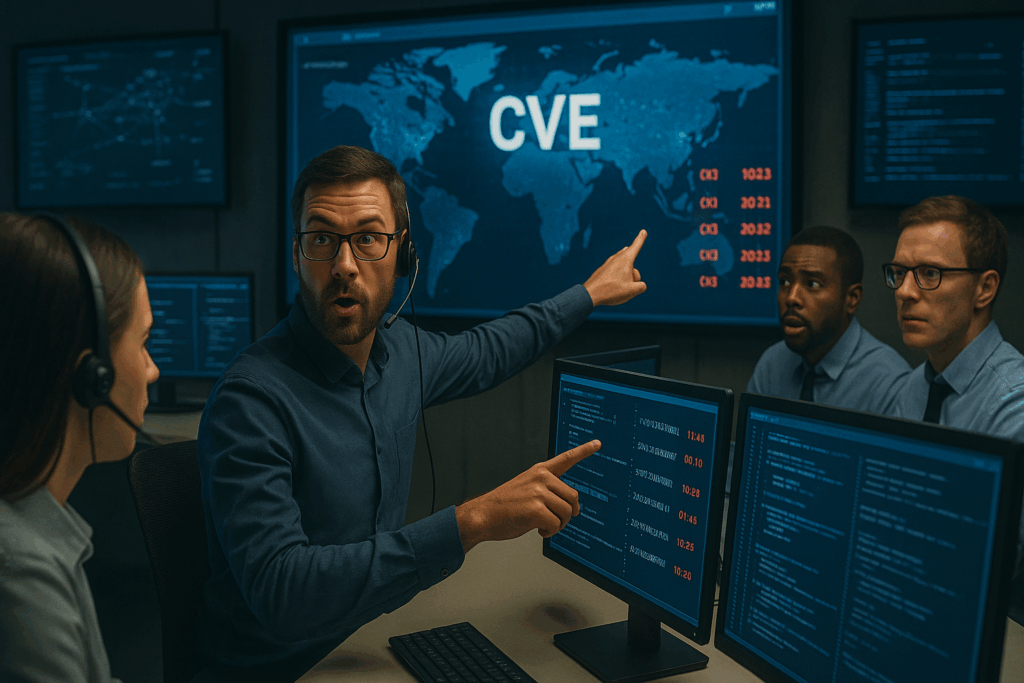Keeping track of CVEs (Common Vulnerabilities and Exposures) relevant to an organization’s infrastructure is neither a passive nor a one-off task. It requires a proactive, systematic strategy aligned with vulnerability management principles established by frameworks such as ISO 27001, NIST CSF, or TISAX. The key is not knowing every CVE, but identifying which ones apply to your assets, critical services, and specific risk context.
The first best practice is to accurately map your asset inventory: hardware, software, operating systems, versions, exposed services, and technologies in use. Without this visibility, any attempt to correlate with vulnerability databases is ineffective. Tools like well-maintained CMDBs, automated scans with OpenVAS, Nessus, or Qualys, and living technical documentation are essential at this stage.
Once the inventory is in place, mechanisms must be established to actively subscribe to and monitor CVE feeds. The NVD (National Vulnerability Database) and MITRE’s CVE list are core references, but insufficient on their own. It’s recommended to integrate vendor feeds (Microsoft, Cisco, VMware, Red Hat, etc.), as well as sources like CISA’s Known Exploited Vulnerabilities, Exploit-DB, or threat intelligence platforms like MISP or ThreatConnect. If you use a SIEM such as Wazuh or OSSIM, you can automate event correlation with published CVEs.
However, awareness alone isn’t enough. Effective management requires context. Not every critical CVSS vulnerability is truly critical for your environment. A CVE with a 9.8 score on a service you don’t run is irrelevant, while a 6.5 vulnerability might be exploitable on an unprotected endpoint or in an unpatchable legacy system. This is where real risk-based prioritization becomes essential. Integrating systems like EPSS (Exploit Prediction Scoring System) can greatly refine this analysis.

A crucial best practice is linking CVE monitoring directly to your ticketing or task management systems. Each CVE alert should trigger a case that documents its potential impact, exposure evidence, and recommended actions: patching, temporary mitigation, or justified risk acceptance. In corporate environments, this process must align with change management cycles to avoid untested patches or unplanned outages.
The human factor matters. IT, development, and security teams must understand the importance of acting on CVEs, not treating them as administrative noise. In mature organizations, relevant CVEs are tracked as KPIs or reported to executive leadership, reinforcing a security-first culture.
In hybrid and cloud environments, where part of the infrastructure is managed by third parties (IaaS, PaaS, SaaS), it’s critical to demand that providers notify you of CVEs affecting them and disclose their remediation timelines. Major platforms like AWS and Azure publish security bulletins that must be reviewed and integrated into your vulnerability triage workflow.
Automation is necessary, but oversight is mandatory. Tools may misprioritize or miss services that are poorly documented. Human review, especially for critical assets, remains essential. Internal audits should be scheduled regularly to confirm whether CVEs published during a given period were reviewed and acted upon properly.
Monitoring CVEs isn’t about checking a list once a week. It’s about establishing a continuous flow of monitoring, correlation, impact analysis, technical decisions, and full traceability. When executed well, it significantly improves your security posture, reduces your attack surface, and builds trust in your infrastructure. Ignoring it, even for a few days, could open the door to a breach that was entirely preventable.

Operationalizing CVE Management: Practical Recommendations
Define a clear vulnerability management policy. This document must assign roles, approved tools, review frequencies, and prioritization criteria. Without it, actions become reactive or inconsistent. Under ISO 27001 or TISAX, this policy should be versioned, reviewed annually, and explicitly define how published CVEs are handled, what triggers immediate action, and how each case is traced.
Automate detection, but never delegate analysis blindly. Scanners like Nessus, OpenVAS, or Rapid7 are efficient at mapping vulnerabilities to CVEs and computing theoretical risk. But they lack business context. You must determine whether a CVE with a 9.8 score on an isolated service matters more than a 6.5 vulnerability on an internet-facing front end. Build a custom criticality matrix that includes CVSS score, asset exposure, business impact, and patching feasibility (especially in legacy or OT systems).
Incorporate CVE feeds into your daily workflow. Don’t just visit MITRE occasionally—configure automatic alerts and RSS/JSON feeds based on your tech stack. MITRE’s CVE portal lets you filter by vendor, product, or vulnerability type. Tools like Vulners, CVE Search, or threat intel platforms can integrate with your SIEM to feed correlations. Custom scripts can query APIs (like NIST’s or MITRE’s) to match your asset versions and produce internal reports automatically.
Keep your asset inventory as a living source of truth. Without this, CVE tracking is guesswork. Use automated discovery tools like Lansweeper, OCS Inventory, or combine Nmap scans with fingerprinting (nmap -sV --script vulners). Your inventory should list OS versions, patch levels, service roles, exposure levels, system owners, and last review dates. This is the basis for all impact analysis.
Assess exploitability in real-world conditions. Not all CVEs are equally exploitable. Many require authenticated access, specific configs, or rare conditions. Use sources like Exploit-DB, Packet Storm, CISA KEV list, or EPSS scoring to evaluate real exploit likelihood. If a public PoC is available on GitHub, Metasploit, or if Shodan shows vulnerable instances, raise the priority immediately.
Establish a recurring workflow. Schedule a weekly CVE review cycle with clear responsibilities: who reviews the new entries, who checks exposure, who approves remediation or risk acceptance. Each CVE tracked should generate a ticket tied to your change management system (e.g., Jira, GLPI, ServiceNow), documenting severity, affected systems, and remediation status. Require traceability.
Don’t rely solely on patching. Some systems can’t be patched (e.g., industrial controls, medical devices, outdated ERP). Use compensating controls: host-based firewalls, network segmentation, IDS/IPS (Snort, Suricata), deactivating vulnerable modules, blocking known signatures at the proxy or WAF level, or enhanced logging. For example, if you can’t patch Apache, harden it by disabling modules and enforcing security headers, while closely monitoring traffic patterns.
Educate your technical staff. Often CVEs are dismissed due to lack of understanding. Run internal workshops explaining real exploitation cases, how to read CVE entries properly (understand CVSS, attack vectors, vulnerability types), and how to assess business impact. This shared knowledge helps distribute the evaluation workload and reduces single points of failure.

Regularly revisit old CVEs. Don’t fall into the trap of only focusing on what’s new. Many breaches come from CVEs published years ago, like EternalBlue or Log4Shell. Define a “Legacy CVE Review” cycle to check whether older but critical vulnerabilities are still unpatched within your environment.
Report to leadership in terms of risk, not technical jargon. When escalating CVEs to management, avoid talking about buffer overflows or code injection. Say: “This vulnerability allows unauthenticated remote code execution and affects our payroll system, which is internet-facing. Public exploits are available. Estimated exposure time exceeds three weeks. High risk of reputational, legal, and operational impact.” That’s what drives decisions.
In short, effective CVE management is a disciplined blend of automation, environmental awareness, team coordination, and informed decision-making. It’s not about knowing the most, it’s about executing well. Done right, it becomes one of the most cost-effective and strategic defenses against real-world attacks.
